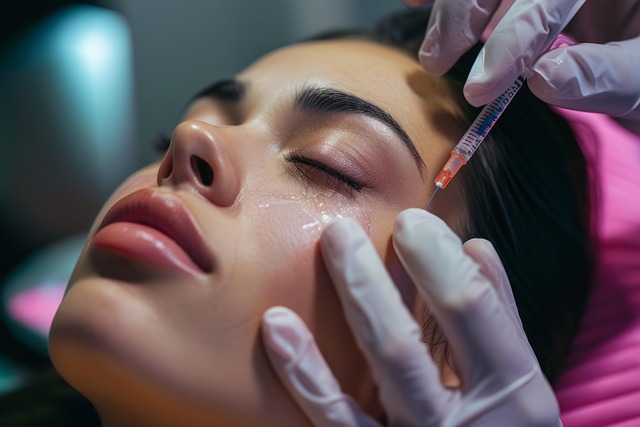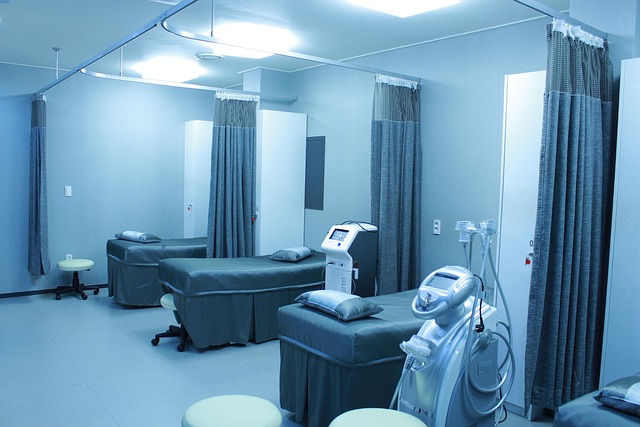Botox treatments offer a popular, non-surgical solution for reducing forehead wrinkles by relaxing muscles that cause them. This temporary yet effective method involves injecting botulinum toxin into specific muscle groups, minimizing lines and creases. Ideal for age-related changes or expression lines, Botox treatments have minimal downtime, no recovery time, and results lasting 3-6 months. Safety and effectiveness are crucial; side effects like mild bruising resolve quickly. Consulting a board-certified specialist ensures optimal results and comfort throughout the process. Proper aftercare post-treatment facilitates a successful recovery, enabling individuals to resume regular activities within a week. Regular top-up sessions maintain long-lasting results.
“Considered one of the most effective non-surgical procedures, Botox offers a solution for those seeking to smoothen forehead lines and reduce the signs of aging. This comprehensive guide delves into the world of Botox treatments specifically tailored for forehead wrinkles. From understanding the causes and types of these lines to exploring the science behind Botox’s effectiveness, we’ll navigate the benefits, safety, and long-term results of this popular anti-aging choice. Discover how Botox treatments can transform your facial appearance, with expert insights on choosing the right specialist.”
Understanding Forehead Lines: Causes and Types

Forehead lines, also known as glabellar lines or frown lines, are a common concern for many individuals seeking cosmetic enhancements. These wrinkles can range from subtle expression lines to deep, etched creases that give an appearance of worry or age. Understanding the causes and types of forehead lines is essential when considering Botox treatments as a potential solution.
There are several factors contributing to the development of frown lines. The most prominent is repeated facial expressions, such as frowning or squinting, which over time can cause the muscles in the forehead to contract and form wrinkles. Ageing is another significant factor, as the skin’s natural production of collagen and elastin decreases, leading to reduced skin elasticity and increased visibility of these expression lines. Environmental factors like sun exposure and smoking can also accelerate the process, making it more pronounced. Botox treatments aim to relax the muscles causing these lines, providing a temporary yet effective solution for smoother, younger-looking skin.
The Role of Botox in Reducing Forehead Wrinkles

Botox has emerged as a popular and effective solution for reducing forehead wrinkles, offering a non-surgical approach to achieving a smoother, more youthful appearance. The treatment works by injecting a small amount of botulinum toxin into specific muscles in the forehead. This protein blocks nerve signals that cause muscle contraction, which over time leads to the formation of wrinkles. By relaxing these muscles, Botox treatments can significantly decrease the depth and visibility of lines and creases on the forehead, creating a more relaxed and rejuvenated look.
This procedure is particularly beneficial for individuals seeking to mitigate the effects of age-related facial changes or those dissatisfied with expression lines caused by frowning or squinting. Many patients appreciate the convenience and minimal downtime associated with Botox treatments, making it an attractive option for those wanting to maintain a youthful appearance without extensive surgery.
How Botox Treatments Work for Forehead Lines

Botox treatments for forehead lines involve injecting a small amount of botulinum toxin into specific muscle groups responsible for frowning and furrowing. This non-invasive procedure works by temporarily paralyzing the muscles, which reduces their ability to contract and form wrinkles. Over time, as the effects of the Botox wear off (typically lasting 3-6 months), the treated area appears smoother and lines become less pronounced.
The precision of Botox treatments is crucial for achieving natural-looking results. Skilled practitioners use fine needles to inject the toxin precisely where it’s needed, minimizing discomfort and side effects. This targeted approach ensures that only the desired muscles are affected, allowing for a significant improvement in forehead lines without altering facial expressions or causing any permanent changes.
Benefits of Non-Surgical Approach with Botox

Botox offers a non-surgical approach to treating forehead lines, which is becoming increasingly popular due to its numerous advantages. Unlike traditional surgical procedures, Botox treatments are minimally invasive, making them an appealing option for those seeking a more subtle and natural improvement. The process involves injecting small amounts of Botox into specific muscle groups responsible for causing dynamic wrinkles. This technique not only reduces the appearance of fine lines and wrinkles but also provides a temporary yet effective solution that can last for several months.
One significant benefit is the absence of recovery time, allowing patients to resume their daily activities immediately after the procedure. Additionally, Botox treatments are known for their precision, as expert practitioners can target problem areas with accuracy, ensuring optimal results without any noticeable scarring or prolonged downtime often associated with surgery. This non-invasive nature makes it an attractive choice for individuals who want to maintain a youthful appearance while avoiding extensive recovery processes.
Safety and Effectiveness of Botox Injections

When considering Botox treatments for forehead lines, it’s essential to understand their safety and effectiveness. Botox is a highly purified protein derived from a bacteria called Clostridium botulinum. When injected into specific muscles, it temporarily blocks nerve signals that cause muscle contraction, leading to reduced wrinkling. Numerous clinical studies have proven its safety and efficacy in treating dynamic facial lines, including those on the forehead.
Botox injections are generally considered safe when administered by a qualified healthcare provider. Potential side effects may include mild bruising, swelling, or headaches at the injection site. While these side effects typically subside within a few days, it’s crucial to choose an experienced practitioner who can minimize these risks. Regular follow-up appointments ensure optimal results and help manage any concerns that may arise during or after the treatment.
What to Expect During a Botox Procedure for Forehead Lines

When considering Botox treatments for forehead lines, it’s important to understand what to expect during the procedure. The process typically begins with a consultation where your healthcare provider will assess your specific concerns and determine the appropriate amount of Botox needed. During the actual treatment, a small needle is used to inject tiny amounts of Botox into targeted areas along the forehead. This procedure is usually quick, often taking less than 15 minutes, and is generally well-tolerated with minimal discomfort.
After the injections, you may experience temporary redness or swelling in the treated areas, but these side effects are usually mild and subside quickly. It’s crucial to follow your provider’s aftercare instructions, which may include avoiding strenuous activity for a short period. Within a week or so, the Botox begins to relax the muscles, reducing the appearance of fine lines and wrinkles on the forehead. Results can last for several months, providing a noticeable improvement in facial aesthetics.
Downtime and Recovery After Botox Treatment

After a Botox treatment for forehead lines, it’s important to be aware of the downtime and recovery process. While results typically start to appear within a few days, it’s common to experience some temporary side effects such as redness, swelling, or mild bruising at the injection sites. These symptoms usually subside within a couple of days. During this time, it’s advisable to avoid strenuous activities, direct sunlight, and certain medications that can increase bleeding risk.
Proper aftercare is key to ensuring optimal results and minimizing discomfort. Patients are often recommended to apply a cold compress for the first 24 hours, rest with their head elevated, and avoid rubbing or touching the treated areas. Most individuals can resume their regular activities within a week, but it’s crucial to follow the healthcare provider’s specific instructions for a smoother recovery process.
Longevity and Maintenance of Results with Botox

Botox treatments for forehead lines offer a significant advantage in terms of longevity compared to other cosmetic procedures. The effects of Botox can last anywhere from 3 to 6 months, providing a sustained reduction in the appearance of wrinkles and fine lines. This long-lasting nature makes it an attractive option for those seeking a more permanent solution without the commitment of surgery.
Regular maintenance is key to preserving the results of Botox treatments. As the body naturally breaks down the injected Botox over time, top-up sessions are often recommended every few months to maintain the desired effect. Skilled practitioners can tailor these maintenance injections to ensure optimal results, allowing individuals to enjoy a smoother, more youthful forehead for an extended period.
Choosing the Right Doctor for Your Botox Forehead Line Treatment

When considering Botox treatments for forehead lines, choosing the right doctor is paramount to achieving optimal results and ensuring your safety. It’s crucial to look for a board-certified dermatologist or plastic surgeon with extensive experience in botulinum toxin injections. Check their credentials, certifications, and any specific training in facial aesthetic procedures. A good practitioner will take the time to understand your concerns, discuss your expectations, and offer personalized advice based on your unique features and skin type.
Reputation matters too. Seek recommendations from friends or family who have undergone similar treatments. Online reviews can also provide valuable insights into a doctor’s skill and bedside manner. An ideal medical professional will make you feel at ease, answer all your questions honestly, and guide you through the entire process, ensuring your comfort both before and after the procedure.
